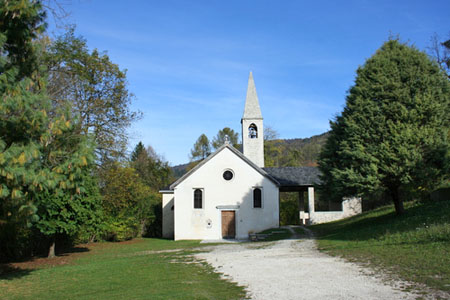| Card n. | Description | Locality | Linked sites |
| 60 | Lactogenic spring of San Mamante | Belluno | 75 - 79 |
| file .pdf | Ethnographic Sites (SE) |
Google maps |
 |
- Description
- How to get there
- Interesting facts
- Bibliography
During his pastoral visit in 1724, Bishop Rota pointed out that “...not far from the church there is another with a vaulted arcade, from where cool water springs to refresh the faithful...”. Just a few steps away from the Church of San Mamante we can still see the barrel-vaulted construction that houses the source of water believed to have beneficial properties, which the saint of the same name is said to have made spring from there just after the sanctuary was built. According to a local legend, the inhabitants of the area began building the sanctuary on the left side of the valley, but since for three days running they found all the stones and the lime on the other side of the river, they decided it was better to move across to the site where the construction can still be seen today. The water is considered lactogenic, i.e. able to stimulate lactation in women who have just given birth, so in the past – and to an extent even today – women come to the Church of San Mamante to pray for help in stimulating the appetite of nursing babies, combatting inflammation of the breasts and increasing the flow of milk. The beneficial properties of the water extended also to lactating animals, and it is even said that the scepticism of a man who provocatively drank the water from the fountain to test its effect was promptly punished by San Mamante, a very popular saint with the faithful of Belluno, who made milk flow abundantly from his nipples. The sanctuary is mentioned for the first time in a document from 1289, and it is likely to have been built in the first half of the 13th century, with further work and decorations dating back to the 16th century. Among the most interesting works of art are the frescoes in the presbytery, part of which have now been lost, traditionally attributed to Pomponio Amalteo (1505-1588), and canvases by Francesco Frigimelica “Il Vecchio” (circa 1570 - post 1646).
Caleipo can be reached from Belluno by going up the road towards Castion – Nevegal. The little church sits up from the road on a small meadow after the first bend on the long straight road for Nevegal, at about 2.2 Km from the centre of Castion.
ACCESSIBLE: along the foot path at the back of the church
MUNICIPALITY: Belluno
PLACE: Caleipo - Sossai
GEOGRAPHICAL COORDINATES: X 1751605 – Y 5112433
PROVINCE: Belluno
FILE COMPILED BY: Barp
From the centre of the village of Sossai, you can reach the waterfalls of the Val di San Mamante, along an unmarked path that starts out from behind the sports field.
On the right bank of the Turriga torrent, which cuts in half the nearby hamlet of Caleipo, you can see an interesting twentieth-century washtub (79 ES) in pinkish stone, with slightly sloping surfaces. The humanist and priest from Belluno Pierio Valeriano defined the Turriga as a “stream of eternal waters”.
F. Vizzutti, Le chiese della parocchia di Castion, documenti di storia e d’arte, Belluno, 2005
Adriano Alpago Novello, Chiese e cappelle rurali nella Val Belluna, Vicenza, 2000
R. Lionetti, Latte di padre. Vitalità, contesti, livelli di lettura di un motivo folklorico, Brescia, 1984
R. Lionetti, Donne al santuario. Il culto di San Mamante nel Bellunese in Balie da latte. Una forma peculiare di emigrazione temporanea, Feltre, 1984
A. Nardo Cibele, Acque. Pregiudizi e leggende bellunesi, Archivio per lo studio delle tradizioni popolari, vol VI, Palermo, 1888

